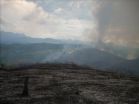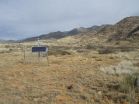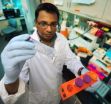(Press-News.org) Until recent decades the Atlantic Rainforest covered a large area of today's Brazil from Amazonas to present-day Argentina. In the 1970s, after years of deforestation, this rain forest was almost completely destroyed, mainly replaced by cattle pastures. This study reveals an unexpected aspect of deforestation. Thorsten Dittmar's team and colleagues from Brazil and the USA show that the common practice of slash and burn left huge amounts of charcoal in the soil. This charcoal is washed out by rainfalls and transported by rivers into the Atlantic Ocean. The soluble fraction of charcoal is composed of extremely stable carbon compounds. The authors conclude that the amounts of these compounds dissolved in the ocean will increase due to human civilization. So far, the effects on marine microorganisms and the global carbon cycle are unknown.
Since way back mankind used fire to shape Earth's vegetation. This was common practice in the 16th century when European settlers came to Brazil, and the beginning of the end of the rain forest. Slash and burn during the centuries reduced its size of 1.3 million to a mere 100,000 square kilometers. What was left was 200-500 millions tons of charred carbon in the soils. These remnants are complex and extremely stable carbon compounds. During the rainy seasons the water elutes the soluble fractions and transports the carbon to the Atlantic Ocean, affecting biogeochemical cycles for centuries and millenia.
In earlier times, the Atlantic rain forest covered a large track of today's Brazil, reaching from 5 to 28 degree south latitude with an area of 1.3 million square kilometers. Until the midst of the 19th century about 95 per cent was intact, but the growing demand for cattle pastures led to massive slash and burn practice which ceased in 1973 leaving only 15 per cent of the original area unaffected. As of today only 8 per cent (100,000 square kilometers) are left.
Thorsten Dittmar and his group at the Max Planck Institute for Marine Microbiology analysed the samples in their laboratories at the University of Oldenburg which are an outpost station of the Bremen based Max Planck Institute. Their main research topic is the carbon cycle and the fate of the dissolved organic matter (DOM) in aquatic, mainly marine, systems. For the sample analysis of the present study they also used their ultrahigh resolution mass spectrometer.
Dittmar explains how they started their rain forest project: "A couple of years ago we detected telltale carbon compounds typical for burnt plant material and charcoal dissolved in ocean water. We speculated that the pre-harvest burning of sugar cane plantations and forest fires in Brazil was a major source. So, we as marine scientists, contacted our colleagues in Brazil, who had taken soil and water samples for years around the Paraiba do Sul river."
The results were surprising. Substantially more carbon compounds where discharged by the river than the annual procedure of pre-harvest burning of sugar cane plantations could produce. "When we plotted the results from the samples against time and compared this pattern with the amount of precipitation and the occurrence of fires, the relation became obvious. The charred carbon must have originated from the slash and burn period from much earlier times."
This assumption was confirmed by further experiments and data. The large scale slash and burn practice ended in 1973. The still practiced pre-harvest burning of the sugar cane plantations produces only 190-740 tons charred carbon annually, but the amount found in the river was three to sixteen times higher. The scientists extrapolated 50,000 to 70,000 tons for the annual load carried by rivers from the total area of the relict rain forest into the Atlantic Ocean. In the laboratory the soil of the rain forest gave the highest yield of carbon compounds in leaching experiments. More and more it became obvious that the sugar cane plantations were not the source, as also high concentrations of charred carbons were detected upstream of the river where only limited numbers of plantation were present.
"There are current discussions in the scientific community about using charred carbon to sequester carbon and thereby removing it from the active global carbon cycle. Our data clearly show that this is not a sustainable procedure, as sooner or later this carbon ends up in the oceans and alters the ecosystem. And we do not know anything about the consequences", Dittmar sums up his concerns. "The soluble fraction of charred carbon is extremely stable in the environment and withstands microbial activities. Therefore, we can trace it in the world's oceans, even in remote places of the deep sea. Our study suggests that this stable fraction of charred carbon in the deep sea will increase due to the increase of anthropogenic activities. The consequences on the marine microorganisms and the global carbon cycle are unknown."
INFORMATION:
Original work:
Thorsten Dittmar, Carlos Eduardo de Rezende, Marcus Manecki, Jutta Niggemann, Alvaro Ramon Coelho Ovalle, Aron Stubbins and Marcelo Correa Bernardes
Continuous flux of dissolved black carbon from a vanished tropical forest biome
Nature Geoscience, 2012. Advanced Online Publication. DOI: 10.1038/ngeo1541
Marine research in the Brazilian rainforest
Slash and burn practice for centuries as source of stable carbon compounds in the oceans
2012-08-14
ELSE PRESS RELEASES FROM THIS DATE:
Girls with ADHD at risk for self-injury, suicide attempts as young adults, says new research
2012-08-14
WASHINGTON – Girls with attention deficit hyperactivity disorder are significantly more likely to attempt suicide or injure themselves as young adults than girls who do not have ADHD, according to research published by the American Psychological Association.
Young women diagnosed with attention deficit hyperactivity disorder as girls, particularly the type with early signs of impulsivity, were three to four times more likely to attempt suicide and two to three times more likely to report injuring themselves than comparable young women in a control group, according to ...
Hope for patients with HIV-associated cognitive impairment
2012-08-14
Current drug therapy for patients with HIV is unable to control the complete replication of the virus in the brain. The drugs therefore do not have any effect against the complications associated with neurocognitive impairment in patients with HIV. New research by Joseph Steiner and colleagues from Johns Hopkins University has discovered that a group of plant polyphenols known as catechins, which naturally occur in green tea and the seed of the cacao tree, may help in the prevention of these neurological complications. Their work is published online in Springer's Journal ...
Scientists uncover strategy able to dramatically reduce chemotherapy's side effects
2012-08-14
Researchers in Leuven (VIB/KU Leuven) have confirmed their hypothesis that normalizing blood vessels by blocking oxygen sensor PHD2 would make chemotherapy more effective. They also demonstrated for the first time that this strategy would reduce the harmful side effects of chemotherapy on healthy organs.
Limited success of chemotherapy
The effectiveness of chemotherapy is first and foremost limited by the difficulties of delivering the anticancer drugs to the actual tumor. Tumors are characterized by abnormally shaped blood vessels – they are irregular in shape, have ...
Nearly 1,000 earthquakes recorded in Arizona over 3 years
2012-08-14
TEMPE, Ariz. – Earthquakes are among the most destructive and common of geologic phenomena. Several million earthquakes are estimated to occur worldwide each year (the vast majority are too small to feel, but their motions can be measured by arrays of seismometers). Historically, most of Arizona has experienced low levels of recorded seismicity, with infrequent moderate and large earthquakes in the state. Comprehensive analyses of seismicity within Arizona have not been previously possible due to a lack of seismic stations in most regions, contributing to the perception ...
Launching a 'social networking war' against cancer
2012-08-14
Experts agree that, more than ever before, modern wars will be fought in the cyber zone, targeting an enemy's communications technology to cause untold damage. Now a Tel Aviv University researcher is suggesting that the same tactics should be employed in the battle against one of the body's deadliest enemies — cancer.
In an article published in Trends in Microbiology, Prof. Eshel Ben-Jacob of TAU's School of Physics and Astronomy and Prof. Herbert Levine of Rice University, long-time bacteria researchers, and Prof. Donald Coffey of Johns Hopkins University, a renowned ...
Studies seek better understanding and treatment of depression
2012-08-14
AUGUSTA, Ga. – Connecting the dots between two molecules whose levels are decreased in depression and increased by current antidepressants could yield new therapies, researchers say.
Serotonin is a neurotransmitter that enables brain cells to communicate and brain-derived neurotropic factor, or BDNF, is a brain-nourishing molecule that also aids connectivity. Popular antidepressants such as Prozac, developed to increase levels of serotonin, have recently been found to also increase BDNF levels, said Dr. Anilkumar Pillai, neuroscientist at the Medical College of Georgia ...
Can specialized HIV community pharmacies improve treatment?
2012-08-14
New Rochelle, NY, August 14, 2012—Community pharmacies with specially trained staff to provide HIV services can help HIV-infected individuals be more compliant with their essential antiviral drug regimens and hence improve patient outcomes. Users of HIV-specialized Walgreen pharmacies across the U.S. had significantly greater adherence to and persistence with their therapeutic drug regimens according to a study published in AIDS Patient Care and STDs, a peer-reviewed journal from Mary Ann Liebert, Inc., publishers. The article is available free on the AIDS Patient Care ...
Closing in on the border between primordial plasma and ordinary matter
2012-08-14
UPTON, NY - Scientists taking advantage of the versatility and new capabilities of the Relativistic Heavy Ion Collider (RHIC), an atom smasher at the U.S. Department of Energy's Brookhaven National Laboratory, have observed first glimpses of a possible boundary separating ordinary nuclear matter, composed of protons and neutrons, from the seething soup of their constituent quarks and gluons that permeated the early universe some 14 billion years ago. Though RHIC physicists have been creating and studying this primordial quark-gluon plasma (QGP) for some time, the latest ...
Impulsive micromanagers help plants to adapt, survive
2012-08-14
EAST LANSING, Mich. — Soil microbes are impulsive. So much so that they help plants face the challenges of a rapidly changing climate.
Jen Lau and Jay Lennon, Michigan State University biologists studied how plants and microbes work together to help plants survive the effects of global changes, such as increased atmospheric CO2 concentrations, warmer temperatures and altered precipitation patterns. The results, appearing in the current issue of the Proceedings of the National Academy of Sciences, showed that microbes in the ground not only interact with plants, but they ...
Scientists devise new strategy to destroy multiple myeloma
2012-08-14
Researchers at Virginia Commonwealth University Massey Cancer Center are reporting promising results from laboratory and animal experiments involving a new combination therapy for multiple myeloma, the second most common form of blood cancer.
The study published online in the journal Cancer Research details a dramatic increase in multiple myeloma cell death caused by a combination of the drugs obatoclax and flavopiridol. The researchers, led by Steven Grant, M.D., Shirley Carter Olsson and Sture Gordon Olsson Chair in Oncology Research, associate director for translational ...
LAST 30 PRESS RELEASES:
Myosin XI-1: A key molecular target for salt-tolerant crops
Pusan National University study highlights the health hazards of ultrafine particles from small home appliances with electric heating coils and brushed DC motors
Global first: New Indigenous-led research initiative to revitalize legal orders
Transforming acoustic waves with a chip
When climate risk hits home, people listen: Study reveals key to engagement with disaster preparedness messaging
Major breakthrough against diabetes thanks to a microbial molecule that disarms inflammation
Silicon chips on the brain: Researchers announce a new generation of brain-computer interface
Getting rest is the best
Towards sustainable organic synthesis – Mechanochemistry replaces lithium with sodium in organic reactions
Wireless device ‘speaks’ to the brain with light
Greenhouse gases to intensify extreme flooding in the Central Himalayas
New study sheds light on Milky Way's mysterious chemical history
Could altering the daily timing of immunotherapy improve survival in people with cancer?
Weaving secondary battery electrodes with fibers and tying them like ropes for both durability and performance
Using social media may impair children’s attention
Science briefing: An update on GLP-1 drugs for obesity
Lower doses of immunotherapy for skin cancer give better results
Why didn’t the senior citizen cross the road? Slower crossings may help people with reduced mobility
ASH 2025: Study suggests that a virtual program focusing on diet and exercise can help reduce side effects of lymphoma treatment
A sound defense: Noisy pupae puff away potential predators
Azacitidine–venetoclax combination outperforms standard care in acute myeloid leukemia patients eligible for intensive chemotherapy
Adding epcoritamab to standard second-line therapy improves follicular lymphoma outcomes
New findings support a chemo-free approach for treating Ph+ ALL
Non-covalent btki pirtobrutinib shows promise as frontline therapy for CLL/SLL
University of Cincinnati experts present research at annual hematology event
ASH 2025: Antibody therapy eradicates traces of multiple myeloma in preliminary trial
ASH 2025: AI uncovers how DNA architecture failures trigger blood cancer
ASH 2025: New study shows that patients can safely receive stem cell transplants from mismatched, unrelated donors
Protective regimen allows successful stem cell transplant even without close genetic match between donor and recipient
Continuous and fixed-duration treatments result in similar outcomes for CLL
[Press-News.org] Marine research in the Brazilian rainforestSlash and burn practice for centuries as source of stable carbon compounds in the oceans




